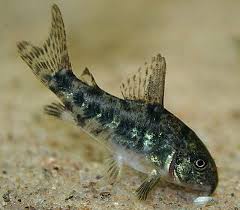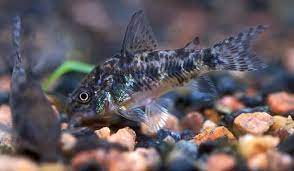Lakes Online Aquariums
Peppered Corydora Catfish
Peppered Corydora Catfish
Couldn't load pickup availability
Pepper corys are small, peaceful fish that can help keep the bottom of your tank sparkling clean. They're also fun, interesting pets that can vocalize during courtship. Another habit they have is "winking" at their owners; their articulated eyes allow them to tilt their eyes down and back up without moving their heads.
Like other corys, this species will sometimes dart to the surface of the water and appear to gulp air. They are able to use atmospheric oxygen, so it is normal to see them do this from time to time. Best kept in small groups, they're a great addition to a community freshwater tank.
Species Overview
COMMON NAMES: Blue leopard corydoras, peppered catfish, peppered cory
SCIENTIFIC NAME: Corydoras paleatus
ADULT SIZE: 2 to 3 inches
LIFE EXPECTANCY: 5 years
Characteristics
| Family | Callichthyidae |
|---|---|
| Origin | Río de la Plata Basin, Argentina, Brazil, Paraguay, Suriname, and Uruguay |
| Social | Peaceful schooling fish |
| Tank Level | Bottom dweller |
| Minimum Tank Size | 15 gallon |
| Diet | Omnivore enjoys live foods |
| Breeding | Egg layer |
| Care | Moderate |
| pH | 6.0 to 7.0 |
| Hardness | Up to 12 dGH |
| Temperature | 72 to 78 degrees Fahrenheit (22 to 26 degrees Celsius) |
Origin and Distribution
Peppered corys are native to South America, where they were first discovered by Charles Darwin during his well-known travels aboard the HMS Beagle during the 1830s. Their home includes the rivers and streams of the Río de la Plata Basin, which is one of the world’s largest river basins. Peppers have been found in rivers, streams, and small lakes in Argentina, Brazil, Paraguay, Suriname, and Uruguay. They are among the earliest fish to be captive-bred for the aquarium trade, having first been bred in captivity in Paris, France, in 1878.
The scientific name for this fish is derived from the Latin words cory (meaning helmet), doras (meaning skin), and palea (meaning chaff or strips of metal foil), a reference to their natural coloration. Pepper corys remain one of the most commonly seen, and most popular, of the Corydoras genus in the aquarium trade. Most specimens sold in shops are captive-bred by commercial breeders in Florida and Asia.
Tankmates
Great for small to large aquariums, this species should be kept in groups of three or more. Ideal tankmates are other small fish, such as small peaceful barbs, danios, livebearers, killifish, small tetras, and dwarf cichlids. Keep in mind that this species prefers colder water, so avoid keeping with species that require the higher end of tropical temperatures. Also, don't keep them with large or aggressive fish.
As with the other members of this family, the pepper cory has razor-sharp barbs under each eye, below the adipose fin, and in the front of the dorsal fin. They are intended to deter larger fish from swallowing them. These can, however, pose problems when attempting to net this little catfish, and care should be taken when doing so. This species is very peaceful, and although quite active during the day, they are also known for sitting in one spot for long periods of time, perusing the area to spot bits of food. They prefer the company of others of their own and do best when kept in shoals.
An interesting behavior in this species is the ability to produce sound by abduction (movement away from the middle of the body) of its pectoral fins. This behavior is generally seen during courtship or in juveniles when they are socially distressed.
Pepper Cory Habitat and Care
As a bottom dweller that spends their days digging through the substrate, this species should be provided with a substrate of either sand or fine smooth-edged gravel, preferably dark in color. Live plants are ideal, but artificial plants can be used as well. The key is to provide plenty of hiding spots to make them feel safe and comfortable. Floating plants are a good option, as this species prefers more subdued lighting. Driftwood or bogwood is also a good means of giving this species places to hide.
Pepper Cory Diet and Feeding
Peppered corys relish live foods but also do well with frozen, flake, granules, and even pellet or tablet foods. Live foods can include bloodworms, brine shrimp, tubifex, and white worms. They are primarily bottom feeders, and although they will occasionally rise to upper levels to grab a tidbit, they dine almost exclusively on the bottom.
Therefore, make sure that food is reaching them. Sinking pellets or tablets are a good way to ensure they are getting their fair share of the food. Although they are active during the day, they will often feed at night, so drop a few sinking tablets in the tank just before turning off the lights to ensure they are well-fed. Deliver live food items by tongs; these may be lodged around tank decor at the base.
Materials
Materials
Shipping & Returns
Shipping & Returns
Dimensions
Dimensions
Care Instructions
Care Instructions




